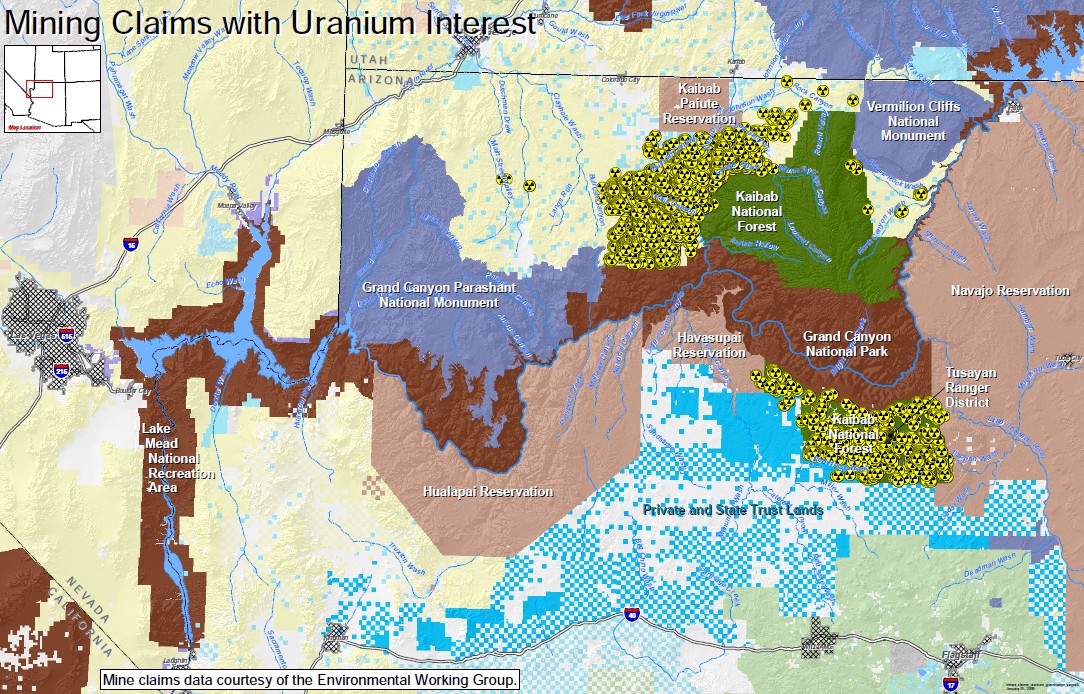
The Obama administration extended its ban on uranium mining this month within the Grand Canyon’s 1-million-acre watershed, putting an end to fears that even more mining claims and resulting mining projects could be on the way.
The decision to safeguard the watershed will last until the end of 2011, around the time an environmental analysis of the issue is set to be released.
“The world would never forgive the permanent pollution of Grand Canyon’s precious aquifers and springs or the industrialization of its surrounding wildlands,” said Randy Serraglio of the Center for Biological Diversity (CBD) on the day of the decision. “The only sure way to prevent pollution of the Grand Canyon is to prevent uranium mining, and today’s action makes important progress toward that goal.”
The Obama administration first declared a two-year moratorium on new mining claims in 2009, after the “public lands” surrounding the Grand Canyon became the site a uranium rush . By the time the moratorium was declared, thousands of mining claims had already been filed.
The Six month extension is a welcomed move; however, there will need to be a more permanent solution, given the long-term risks of uranium mining and the legacy of harm it has already brought to the grand canyon’s ecosystem not to mention the Hopi and Navajo Peoples.
Right now, “there are thousands of uranium mines that are around the Navajo Nation that have been abandoned; nothing has been cleaned up. So why are the federal government and these mining corporations considering opening new mines when they haven’t even cleaned up these other ones?” says Klee Benally, an activist from Indigenous Media Action.
“I hope that people wake up and learn from tragedies like what happened in Japan, and of course we learn from Chernobyl and Three Mile Island. I hope people wise up and realize that we have no future in nuclear power. We have no future in being connected to uranium, from the weapons, to the waste, to the mining. It’s unhealthy for our communities and it is totally unsustainable.”
An accident, such as what happened in 1979, when 1,100 tons of radioactive waste and 90 million gallons of contaminated water went straight into a tributary of the Little Colorado River, could devastate the Grand Canyon Watershed, which provides water to some 27 million people for drinking and agricultural purposes.
Flash floods, which frequent the region surrounding the Grand Canyon, could be equally devastating. For example, in 1984 “a flash flood released tons of tailings from Hack Canyon Mine into Kanab Creek, north of the Canyon. The area is still littered with radioactive waste, and water in the drainage is undrinkable,” notes the Sierra Club’s “Reasons to support the Grand Canyon-area Mining Withdrawal”.
On the bright side, Interior Secretary Ken Salazar, who announced the extended ban, also announced his support for a 20-year mineral withdrawal across the same million acres.
“This is good news for the Grand Canyon, but we are disappointed that Secretary Salazar continues to show such enthusiasm for the mining of existing claims,” said Serraglio. “We hope the ‘caution, wisdom and science’ cited by the secretary as being so important in managing this precious area will lead to strong decisions to protect it from further pollution by uranium mining.”
Both the CBD and the Sierra Club, along with the Grand Canyon Trust, the Havasupai Tribe and the Kaibab Band of Paiute Indians, are hoping that same “caution, wisdom and science” will be extended to their joint lawsuit against the Arizona 1 uranium mine. In 2009, the Bureau of Land Management gave the Canadian mining company Denison Mines Corp. a green light to resume the mining operation.
Despite the ongoing lawsuit, in March 2011, the Arizona Department of Environmental Quality (ADEQ) also issued air and water quality permits for four uranium mines including Arizona 1 and the proposed Canyon Mine near Red Butte.
Red Butte, located twelve miles south of the rim of the Grand Canyon, is a sacred and religious place for the Havasupai People. It’s also located on their ancestral land. The Havasupai say that the destruction of Red Butte, or “Wii’i gdwiisa”, would destroy them and their world.
“If our sacred site is destroyed, it will destroy our Mother. Our right to practice a vital part of our religion and gather paints and medicines for ceremonial use could be rendered meaningless if our Mother is killed.”
“The danger the mine poses to our religion is, for Havasupai, a matter of life and death.”
What You Can Do
Support the proposed Grand Canyon Watershed Protection Act!
Let Congress know you support Secretary Salazar’s wild lands policy
Send a message to Denison Mines Corp. and the Arizona Department of Environmental Quality (before you do, check out these videos)
Write a letter to your newspaper
For more information, visit www.grandcanyontrust.org, www.stopuraniummining.org, and arizona.sierraclub.org

Indigenous Peoples are putting their bodies on the line and it's our responsibility to make sure you know why. That takes time, expertise and resources - and we're up against a constant tide of misinformation and distorted coverage. By supporting IC you're empowering the kind of journalism we need, at the moment we need it most.